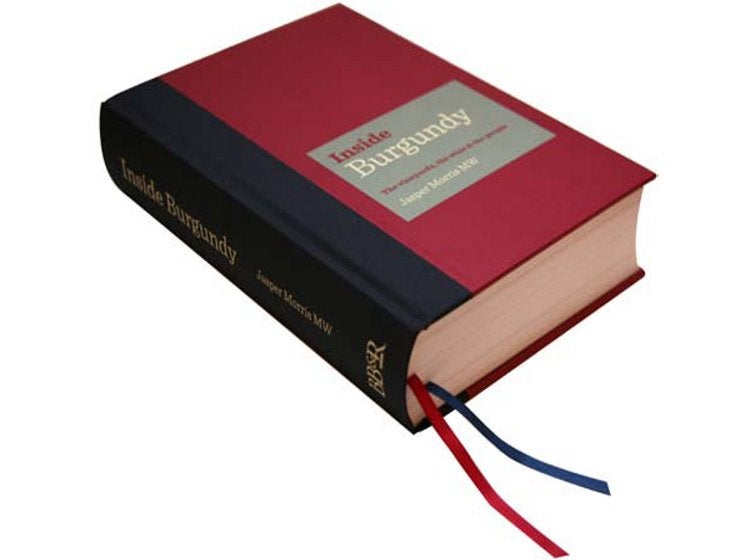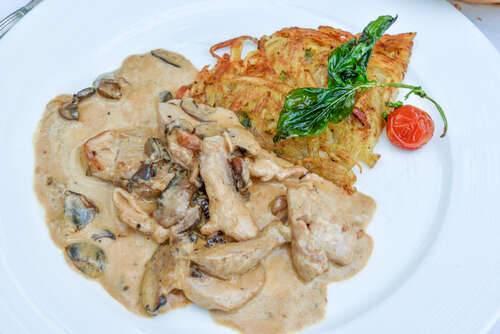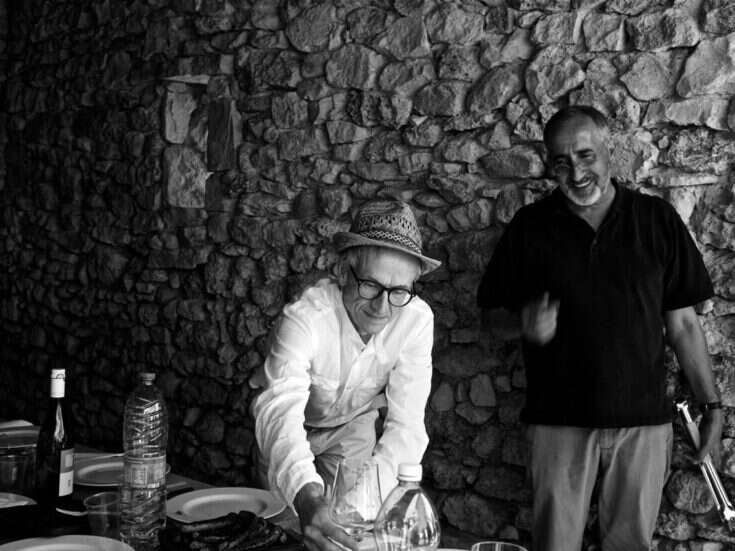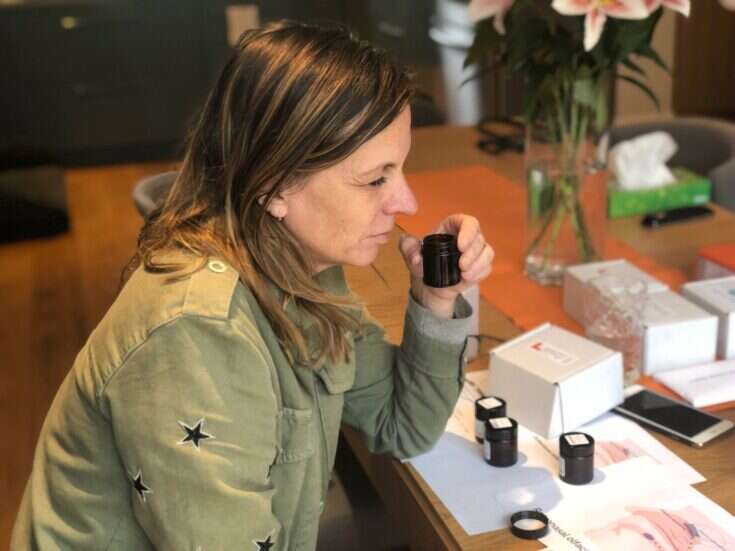
Jasper Morris MW
Inside Burgundy: The Vineyards, The Wine, The People
Berry Bros & Rudd Press $75 / £50
Reviewed by David Schildknecht
Jasper Morris MW has put between covers-a hefty pair of them, enclosing 656 pages that appear admirably weighted to weather decades of thumbingthrough- a synopsis, as its title suggests, of La Bourgogne Viticole, in which terroir, the wines themselves, as well as the human characters that have shaped them, all receive due, detailed consideration. And there can be few Anglophones better suited to the task of unraveling the attendant complexities than Morris, to whom I fondly recall having been introduced just over a quarter-century ago in Burgundy as the sharpest and most sympathetic of a vast international cast of frequently visiting merchants, 90 percent of whom were at the time considerably his seniors.
In 84 preparatory pages, Morris attempts to cover all the necessary details, historical, mercantile, geographical and geological, meteorological and climatic, ampelographic, viticultural, stylistic, and vinificatory (in that order)-a tall order that he fills with mixed success. Whether from an intention (in which he succeeds) to give those already familiar with Burgundy and its wines reason to peruse his account, or simply because he has not imaginatively put himself in the position of readers who might approach this as their portal to Burgundy wine, there are numerous questions-often on topics adumbrated elsewhere in Morris’s book-that one fears not just novices will pose in vain. Morris has compiled a fascinating array of historical references and quotations, but perhaps-as an example-several pages devoted to Gauls, Romans, Burgundians, Franks, and “The Nibelungs: giants or dwarves?” could have been utilized instead to help readers comprehend, say, the nature and importance of clones and sélections massales of Pinot Noir, whose treatment-notwithstanding five brief paragraphs so titled-is cursory, not attempting to define or characterize Pinot Fin other than noting that “growers talk of Pinot Fin ([=] good).” And speaking of cultivars, it’s odd that Morris treats Pinot Blanc in just two sentences, the first of which reads: “Pinot Blanc is a degeneration of Pinot Noir into a white grape.” Yet four paragraphs devoted to the much less frequently encountered Pinot Gris fail to point out that it is on the same genetic footing as Pinot’s white variant.
Erudite etymological excursions elsewhere in the book-often including growers’ alternate accounts of the name of a vineyard-are another case where even experienced observers will be informed and entertained, but arguably the space could have been better used to satisfy the curiosities of a broader readership.
Avoiding conceptual confusions
Morris does an excellent job of steering his reader around conceptual confusions and abuses of those loaded terms “terroir” and “ripeness” -in itself no mean feat. However, with the exception of one provocative quotation from Allen Meadows, on which he offers the merest gloss, the authorities cited on the subject of ripeness wrote in 1831 (Dr Morelot) and earlier. Surely an account of the diverse operational definitions and disagreements that nowadays prevail among growers (even if one leaves out wine critics) would have been helpful. There are instances where Morris’s text appears to presuppose a line of argument-or possibly even an idiolect-for which no further explanation is forthcoming. For example, when he writes that “Chardonnay is far removed from the elegance of Pinot Noir,” I doubt I shall be alone in wondering quite what he means. Six paragraphs devoted to vendange entier -without defining the term as such- neglect to cite a plausible reason (in terms of aroma, flavor, or texture) why anyone would prefer to include stems in the fermenter. Speaking of definitions, a one-page glossary is hardly adequate for Morris’s text, not to mention his subject matter.
Unique and useful features A noteworthy virtue of this book for experts and beginners alike is the considerably improved rendering of the colorful Pitiot and Poupon vineyard maps that in their original form have already become standard references. (There are still instances, however, where details discussed in the text lack corresponding specifications on the maps.) Another unique and useful feature is Morris’s inclusion of no fewer than four classifications for each vineyard profiled: those of Jules Lavalle (1855), Camille Rodier (1920), today’s INA O, and the author’s own. To render Lavalle’s rankings plausible and internally coherent requires some textual analysis and conjecture that Morris painstakingly undertakes.
Unfortunately, anyone writing 150 years hence would have trouble returning the favor. An upgrade to grand cru is suggested for Les Amoureuses, but other sites are variously proposed as “exceptional premier cru,” “outstanding premier cru,” or “leading premier cru,” without explication. A class of “exceptional grand cru” is proposed, and numerous suggestions are made for consolidating existing crus. If the authorities were to implement every change that Morris unambiguously advocates, the resulting hierarchy would, no doubt, less often confuse and better reflect the genuine early 21st-century potential of Burgundy’s sites-not that he harbors any illusions that wholesale revision will take place. Morris’s default mode, perhaps inevitably, is acquiescence in those instances where he has no experience to either corroborate or call into question the existing classification; and the number of instances-notably in less well-known communes-where he candidly admits to having only a look at the map and the vineyard itself to go by, rather than any tasting experience, is a reminder of how much about Burgundy remains obscure due to the sheer multiplicity of sites and growers.
Morris misses two opportunities afforded by his attempts at reclassification. First, his proposals address only existing crus-including those that he argues should have only village status-while not according the many non-cru lieux-dits that he briefly profiles consideration as possible crus. It’s hard to imagine- and his praise of certain wines renders this yet less likely-that he believes from experience or on principle that not one lieu-dit is worthy of upgrade. A second missed opportunity relates to another seemingly unresolved inconsistency, if not really one of Morris’s making.
The less prestigious a Côte d’Or village, the less likely Morris is to challenge its existing premiers crus. (He wisely exempts from assessment the classifications of Chablis, with its nesting of crus, and the Côte Chalonnaise, with its surfeit or absence of crus, depending on the village.) But are wine lovers exploring Burgundy to suppose that, say, the dozen premiers crus of Santenay, the 14 from Monthelie, let alone the half dozen in Maranges are not only entirely in order but implicitly superior to several premiers crus in Volnay (or elsewhere) that Morris advocates demoting? In truth, the term “premier cru” is widely treated just as a naive consumer would interpret it on a label-namely as having a consistent meaning throughout Burgundy. Yet any serious student of the wines will conclude that this approbation is relative to commune. If one proposes revisions at all, then one should address this elephantine ambiguity, whose relevance is ongoing-as witness the current proposal to institute Marsannay premiers crus. Should they be judged by the standards of Gevrey? Is some degree of absolute quality presupposed? Or is this a matter of internal promotion, the burden of proof merely that of establishing a hierarchy of quality by site?
Communal organization
The meat of Morris’s book proceeds by commune. (Beaujolais-distinct from the rest of Burgundy-is not treated.) It is generous, nutritious, and, thanks to his arch style, not in the least hard to chew. Each commune is treated in two detailed sections, the first offering a profile of the relevant vineyards and the latter of the growers. For those vineyards deemed to be of special significance, Morris offers a breakdown of ownership by grower, while holdings of those growers deemed most important are broken down by appellation and vineyard. A selection of individual wines from that grower-at times amounting to the majority of those he or she bottles, at times numbering only a couple- are further profiled. Naturally enough, any experienced reader may quibble about some of the choices made.
Certain growers possessed of notoriously difficult personalities- Guffens and Roty are two excellent examples-get rather short shrift, and then flippantly. Morris incorporates aspects of two pioneering works on his subject: Anthony Hanson’s 1982 Burgundy, with its wealth of anecdotes, insights, and provocative quips; and Matt Kramer’s 1990 Making Sense of Burgundy, with its detailed research on vineyard ownership. At times, he surpasses Hanson in entertaining the reader with facts or tales interesting for their arcaneness but arguably at the expense of greater insight.
Even within the admittedly restricted parameters of a thumbnail sketch (though some of Morris’s grower profiles take up a page or more and involve considerable historical or vinificatory detail), and acknowledging the difficulty of characterizing wine styles, his attempts to capture how the wines taste-when an attempt is made at all-vary from trenchant, through prosaic, to tendentious. Frédéric Magnien’s are dismissed as “wines as modern as the presentation, with flamboyant labels on turbo-charged bottles: enormously to the taste of some consumers but less so to others.”
But does Morris simply expect that his reader already knows into which group he or she will fall? About Domaine Bertheau, Morris writes of his “special affection for this domaine,” since his carpenter worked part time there and presented him with two old bottles “when we dropped in to pay the bill.” But he is silent concerning François Bertheau’s singular style of wine. Occasionally, Morris’s judgments seem overstated, perhaps out of rhetorical zeal, and overlook potentially misleading implications.
Of Chapelle-Chambertin, for example, we read: “For many years I had never had a decent bottle of this wine,” followed by praise for turnabouts in its exemplification chez Damoy and Rossignol-Trapet. But beside this text, readers will note among eight landholders in this appellation Claude Dugat, Louis Jadot, Domaine Ponsot, and Cécile Tremblay and wonder whether its terroir has somehow failed these exceptional growers. (My own answer: “hardly.”) Few if any people can taste every appellation from every major grower, but while Morris is sometimes disarmingly frank about wines he has never tasted, on occasion readers have to puzzle this out from the text-something few will have patience for-or be left wondering where direct experience leaves off and resort to received opinion begins. Estate visits are sometimes described as, or suggested to have been, one-offs. One it would be tough to top for candidness and entertainment, if also the triumph of anecdote over substance, concerns Domaine Michel Ampeau: “I only visited the domaine once, late in the evening after spending the day at the Paulée de Meursault. I do not remember much about it, but apparently I excelled myself at the traditional blind tasting in a way I am sure I would not have done sober.”
Insider’s knowledge
Fortunately, though, not only has Morris forgotten more about Burgundy than all but a handful of its admirers know, he has also assembled as vast a collection of useful details-generally very much up to date-as I can recall having found in another book on this subject. Those with experience will find statements to question or details they think unwisely omitted, but it is to be hoped that Inside Burgundy will attract sufficient interest to merit an updated, improved edition. Apropos which, it’s not clear that book profitability per se would guide its publisher to update, since this is an in-house job by Morris’s employer. For that reason, too, questions of potential conflicts of interest, such as arise whenever an author is also a member of the wine trade, will understandably be heightened. Morris has done the only sensible thing. He does not attempt a ranking of growers. And he has clearly taken great pains to be scrupulously fair, without attempting to hide an affection that naturally extends to those growers with whom he works. But there is limited point to his professing having done this (and he devotes only a few brief paragraphs to the task), since a reader not already familiar with the subject matter will have to take the word of some third party (perhaps a reviewer?) or else consult a copy of Berry Bros & Rudd’s portfolio to judge whether this book’s contents appear to favor that chosen group. Anyone well versed in Burgundy will have his or her shortlist of growers deemed inexplicably or with alleged injustice overlooked in Morris’s profiles; and axiomatically none of these is going to be someone whose wines he sells. But I am confident that each such shortlist will prove different from the next, tending to confirm that no omission was partisan. This is a book that belongs on the shelf of all serious Burgundy lovers, and of those who would discover its wines and will spare the price of one good bottle.
Distributed in the UK by Berry Bros & Rudd (www.bbr.com) and in the USA by Sotheby’s (www.sothebyswine.com)







